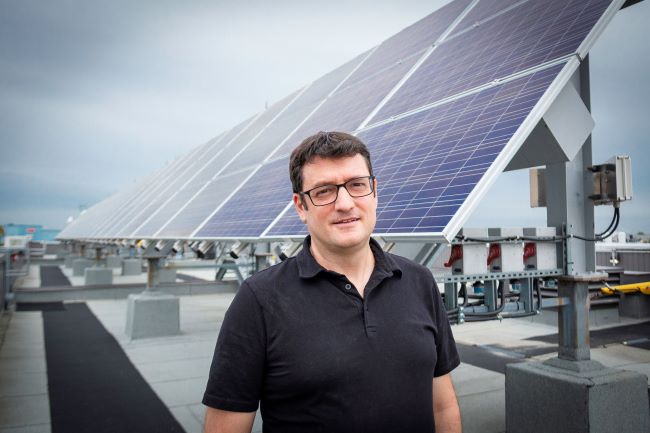When doesn’t Sunday fall on a Sunday? When it’s Sun Day, May 3 — a special day set aside every year to appreciate solar energy. As nations around the world look for ways to achieve net-zero emissions, one of the greatest sources of clean energy is beaming down from the blue sky above — on clear days, of course.
May 2022
Across Canada, on any given day, the sun is beaming down — at least in some parts of the country. Despite our short winter days, solar energy will be a valuable resource as we strive to reduce greenhouse gas (GHG) emissions. For one thing, it’s one of the most abundant renewable sources on the planet. Yet it has often been overlooked — but not any more.
Advances in photovoltaic (PV) technology have made it possible for solar panels to capture the sun’s energy and convert it into electricity just about anywhere. You can see these advanced solar cells at work in panels on top of buildings, in open fields, on streetlights and in carports, among other places. Solar energy is so appealing that even carmakers are exploring the idea of solar-powered vehicles.
It’s a long way from when solar energy was first touted as an alternative energy source in the 1980s.

Yves Poissant, research manager and solar photovoltaic technology specialist at CanmetENERGY in Varennes, Quebec
Time for another look
For one thing, the cost of a solar panel has decreased dramatically since the ‘80s. As a result, a residential PV system that would have cost hundreds of thousands of dollars to install and operate 40 years ago now costs about the same as using traditional electricity sources in Canada.
“It’s time for another look,” says Yves Poissant, research manager and solar photovoltaic technology specialist at CanmetENERGY in Varennes, Quebec. “Now that solar photovoltaics is one of the cheapest new sources of energy — second only to wind, it’s poised to make a significant contribution to the decarbonization of our electricity system.”
Aside from being cost-effective for many uses, solar energy is also extremely clean. A solar PV system produces no GHG emissions during operation and very few emissions over its life cycle. “In fact, PV systems reduce GHG emissions by 96 percent when compared with electricity produced by coal plants,” points out Yves. “By integrating more solar energy into our electricity grid, we help to clean our electricity production and advance toward our net-zero goal.”
An untapped resource
Yves suggests the easiest way for Canadians to tap into solar energy on a personal level is to install solar panels on the roof of their house — something he did 10 years ago and 50,000 other Canadian households have done in the last 20 years. “If the roof is well-exposed to the sun and has little shade from nearby buildings, it’s a great first step,” he says.

One way for Canadians to tap into solar energy is to install solar panels on the roof of their homes. (Photo: iStock)
In fact, his house is a model for anyone looking to go solar. He estimates that — through numerous energy efficiency measures and by providing 30 percent of the heating and electricity needs through solar power — his home requires a third of the electricity used by similar homes in his neighbourhood. And he claims there might be a little-known secret advantage. “The fruits and vegetables we grow in the garden represent another successful demonstration of solar energy use. At least they’re the tastiest!” (Editor’s note: Yves hasn’t yet had time to test the scientific validity of that statement.)
And for those who can’t install solar panels on their roof, there’s still the option of getting involved in solar community projects.
Global perspectives
The future for solar energy around the world is bright indeed. This year, the use of solar PV systems reached a significant milestone. Globally, grid-connected solar PV capacity reached one terawatt — that’s more than six times the total electricity production capacity in Canada.
In 2022, solar electricity will meet more than 4% of global electricity demand. In Canada, however, solar PV electricity currently accounts for less than 1% of our total electricity production.
That’s one reason why the research undertaken by the Renewable Energy Integration Program at CanmetENERGY Varennes is so crucial. Here, Yves and his team are involved in a variety of projects to reduce our reliance on fossil fuel. They assess PV systems in Canada, explore ways to integrate solar and wind technologies in northern and remote communities, and examine new and effective ways to provide solar energy to Canadian electricity grids on a very large scale. Natural Resources Canada research targets specific knowledge gaps to build a solid scientific knowledge base to support decision-making.
Flexibility will be key
Clearly, harnessing solar energy is just one piece of the net-zero puzzle. It’s especially challenging across Canada’s vast landmass and with our short winter days. Additionally, solar electricity can’t be produced on demand like hydroelectricity or thermal generation through fossil fuels and nuclear and energy. So building flexibility into the system will be key to balancing demand with production moving forward.
With the future of solar energy shining so bright for this Sun Day — and next Sunday for that matter — why not give it another look?
For more information:
Explore:
NRCan’s CanmetENERGY PV testing facility in Varennes
More about CanmetENERGY Varennes
Solar PV potential and resource maps for Canada
Read:
Sun in a box, solar panels put to the test